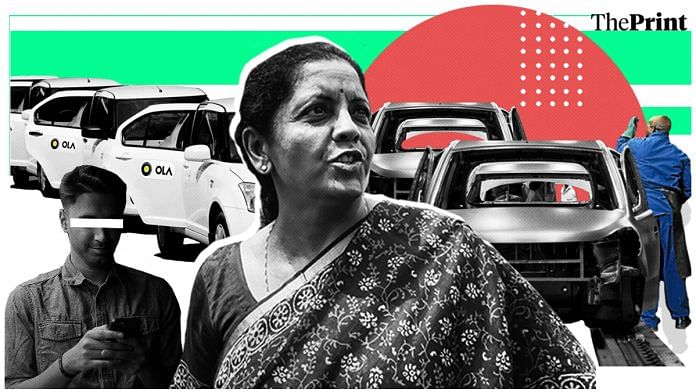Finance Minister Nirmala Sitharaman has said that the automobile sector, facing its worst slowdown, has been ‘affected by the mindset of millennials’ who don’t want to pay EMIs for a vehicle and prefer Ola and Uber rides. India’s automobile industry is witnessing job losses and the biggest decline in sale of passenger vehicles in the past two decades.
ThePrint asks: Nirmala Sitharaman right to point at millennials’ Uber-Ola use and EMI fear for auto slump?
Nirmala Sitharaman must know most millennials can’t afford expensive cab rides for daily commute

Gurmehar Kaur
Student activist and author
We are living in a world where everyone has an opinion, as they should, about everything from science to politics to education and aren’t shy at all to announce it to the world through social media. In the recent past, this has often given us some of the most ridiculous and often funny arguments that make the front news, but I have never heard of something sillier than this Uber-Ola comment, and it shocks me that it came from Finance Minister Nirmala Sitharaman.
I come from a small town where there is no Ola and Uber and where there is no metro. When the Finance Minister puts the blame on millennials for the slump in the automobile sector, she forgets that these millennials comprise a very small percentage of the population that reside in urban cities. These millennials even within those urban cities belong to the more privileged and upper-class communities— ones who can afford the expensive cab rides for their daily commute.
As a millennial, this comment made me feel scared for my own future in this country because there are no jobs for us, and the GDP growth rate is alarming. To top it all, my Finance Minister has confidently blamed a huge part of this slowdown to the Indian youth’s use of ride-sharing services as opposed to taking responsibility for it and giving out a solid plan of action for the future.
Also read: Nirmala Sitharaman must stop stonewalling questions on slowdown. Denial mode isn’t an option
With Ola & Uber at service, owning a car is not as much a priority as it once used to be
 Karthik Shashidhar
Karthik Shashidhar
Management consultant
As someone living in Bengaluru who only recently bought a car, I understand why others are not buying cars. Driving is increasingly becoming an unpleasant activity. Road capacity has not kept up with population and vehicle growth, and that’s why the average time spent on commuting has gone up.
Moreover, gross mispricing of parking spaces — add to the difficulty in finding a parking space and then a few hundred metres walk from the parking spot to the destination – deters people from taking their cars out.
This suggests that private car usage is not growing – though we need to look at data on urban petrol sales to corroborate this. As people do not use cars that frequently now, they upgrade or replace cars less often. People take time to upgrade from two-wheelers to cars. The availability of quality urban transport, such as Uber and Ola, means that owning a car today is not as much a priority as it once used to be.
Also read: Millennials’ preference for Ola, Uber added to auto sector slowdown: Nirmala Sitharaman
Fashionable to blame millennials for everything. Nirmala Sitharaman’s argument is incorrect
 Kushan Mitra
Kushan Mitra
Managing editor, The Pioneer and auto-enthusiast
Nirmala Sitharaman’s argument that millennials fear EMIs and use Uber and Ola is incorrect. I say this because these ride-sharing apps charge a lot and it does not make sense to not buy a car. One almost spends close to Rs 800-1000 a day for using either Uber or Ola to travel across the city.
One can argue that some urban youngsters now prefer taking the Metro or other modes of public transport to travel within the city. For short distances, an Ola or an Uber auto makes sense, but again the number of people using these services is miniscule.
For most Indians, a car is like an extension of their personality. Therefore, I do not believe the slump in the automobile industry is because millennials are using Uber and Ola services. It has become fashionable to blame millennials for everything, but the fact is that rich millennials who are not buying cars are but a minuscule fraction of our population.
Fewer millennials are buying cars now, but there could be more than one reason for that
 Namrata Rana
Namrata Rana
Author of Balance: Responsible Business for the Digital Age
Finance Minister Nirmala Sitharaman is right in saying that fewer millennials are buying cars now. But the reasons could be more than one. It’s not just among millennials, this trend is being witnessed across generations.
We are seeing cultural shifts impacting businesses and customer behaviour across the world as sustainability, climate change and the gig economy are changing the way people think.
To tackle pollution and climate change, people are opting for public transport and it is being encouraged. With parking rates becoming more expensive, high cost of fuel, and now the exorbitant fines under the amended Motor Vehicles Act, it makes so much more sense to travel by public transport.
While we need to look at current numbers to determine the reasons for the economic slowdown, which encompasses many other sectors, we also need to consider being flexible when the economy is undergoing a rapid change. For instance, a purchase made now should take into account its financial impact in the future. Sentiments define purchases. If one is optimistic, one plans and invests. People are postponing long-term commitments to manage uncertain elements that they foresee.
So, the current business environment reflects a state of transition. The slowdown needs to be addressed through collaborative, systems-driven approach. How fast we move to a new state will depend on the kind of collaborative pathways we can create.
Research suggests primary drivers of slump are NBFC liquidity crisis and declining rural wages
 Mandar Kagade
Mandar Kagade
Policy Consultant
Finance Minister Nirmala Sitharaman’s observation for the slump in the automobile industry has got some “press love”. But are millennials’ preference for shared mobility services one of the factors responsible for this slump?
Let’s look at the data. As per a research conducted by the SBI, the total quarterly production of automobiles recorded an increase between 2014 and 2019 (from 5.66 million to 7.21 million). As against this, the quarterly registrations recorded a year-on-year decline of 0.32 million in June 2019. The econometric decomposition of determinants driving the automobile sector slowdown suggests the following weightage of the factors: decline in NBFC Loans 30 per cent, decline in rural wages 20 per cent, Axle norms and the increased insurance costs 20 per cent, and other factors like secondary auto sales/EV policy/car rentals (shared mobility) 30 per cent.
This research suggests the primary drivers of the slowdown are a combination of factors: the NBFC liquidity crisis, and declining rural wages. Moreover, the production data cited earlier jives well with the observation made by Bajaj Auto’s managing director Rajiv Bajaj on this issue.
Indian OEMs appear to have become complacent about demand in the domestic market and are now stuck with excess inventory as wages have secularly declined. To summarise, it is undeniable that the automobile sector is witnessing a structural shift in consumer preferences and these will come to manifest in the long term. It is also true that millennials would be at the vanguard of this structural shift (as a Deloitte study points out). However, the present slump in the automobile sector is attributable to vectors other than the millennials.
By Revathi Krishnan, journalist at ThePrint




This quote appeared in a recentWhatsApp forward, which also said that restaurants were empty because people were ordering food to be delivered at home. Many were quick to point out that truck and motor cycle sales were also dismal. For that matter Ola and Uber were seeing sluggish growth in revenues. 2. Over the last few years, an entire eco system of communication, heavily centred on social media, has evolved, the basis of which is partisan fudge and spin. The Congress managed to puncture this quite effectively during the Gujarat election with the Vikas Gando thhaye chhe campaign. 3. The troll armies can slog it out in the trenches. However, government messaging has to come out of the bubble / cocoon. It is not carrying conviction any longer.
ashok – you better start reading from diverse sources instead of being a Sonia supporter masquerading as a serious reader. I would recommend start with browsing news on ‘automobile sales’ and refer to your favourite ‘gold standard’ western media sources. Check out the ‘Economist’ cover story ‘Slobalisation’. Honestly suggest that be a little less biased and stop pretending to be a wise old man on The Print’s comments section. Be balanced or admit that you are a marxist-communist-dynasty sycophant all rolled into one.
Hamein Print se hi fursat nahin milti, The Economist toh college days mein padhte thay …
Ola and Uber have clicked 4% growth during the last six months. So the proposition does not hold up.